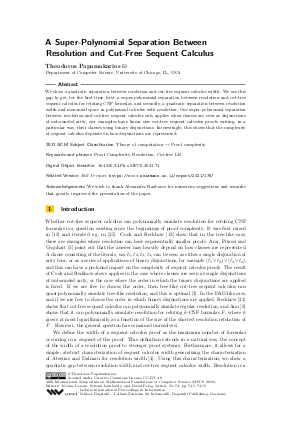A Super-Polynomial Separation Between Resolution and Cut-Free Sequent Calculus
Author Theodoros Papamakarios
-
Part of:
Volume:
48th International Symposium on Mathematical Foundations of Computer Science (MFCS 2023)
Part of: Series: Leibniz International Proceedings in Informatics (LIPIcs)
Part of: Conference: Mathematical Foundations of Computer Science (MFCS) - License:
 Creative Commons Attribution 4.0 International license
Creative Commons Attribution 4.0 International license
- Publication Date: 2023-08-21
File

PDF
LIPIcs.MFCS.2023.74.pdf
- Filesize: 0.65 MB
- 15 pages
Document Identifiers
Related Versions
- Full Version https://eccc.weizmann.ac.il/report/2021/176/
Subject Classification
ACM Subject Classification
- Theory of computation → Proof complexity
Keywords
- Proof Complexity
- Resolution
- Cut-free LK
Metrics
- Access Statistics
-
Total Accesses (updated on a weekly basis)
0PDF Downloads0Metadata Views
Abstract
We show a quadratic separation between resolution and cut-free sequent calculus width. We use this gap to get, for the first time, first, a super-polynomial separation between resolution and cut-free sequent calculus for refuting CNF formulas, and secondly, a quadratic separation between resolution width and monomial space in polynomial calculus with resolution. Our super-polynomial separation between resolution and cut-free sequent calculus only applies when clauses are seen as disjunctions of unbounded arity; our examples have linear size cut-free sequent calculus proofs writing, in a particular way, their clauses using binary disjunctions. Interestingly, this shows that the complexity of sequent calculus depends on how disjunctions are represented.
Cite As Get BibTex
Theodoros Papamakarios. A Super-Polynomial Separation Between Resolution and Cut-Free Sequent Calculus. In 48th International Symposium on Mathematical Foundations of Computer Science (MFCS 2023). Leibniz International Proceedings in Informatics (LIPIcs), Volume 272, pp. 74:1-74:15, Schloss Dagstuhl – Leibniz-Zentrum für Informatik (2023)
https://doi.org/10.4230/LIPIcs.MFCS.2023.74
BibTex
@InProceedings{papamakarios:LIPIcs.MFCS.2023.74,
author = {Papamakarios, Theodoros},
title = {{A Super-Polynomial Separation Between Resolution and Cut-Free Sequent Calculus}},
booktitle = {48th International Symposium on Mathematical Foundations of Computer Science (MFCS 2023)},
pages = {74:1--74:15},
series = {Leibniz International Proceedings in Informatics (LIPIcs)},
ISBN = {978-3-95977-292-1},
ISSN = {1868-8969},
year = {2023},
volume = {272},
editor = {Leroux, J\'{e}r\^{o}me and Lombardy, Sylvain and Peleg, David},
publisher = {Schloss Dagstuhl -- Leibniz-Zentrum f{\"u}r Informatik},
address = {Dagstuhl, Germany},
URL = {https://drops.dagstuhl.de/entities/document/10.4230/LIPIcs.MFCS.2023.74},
URN = {urn:nbn:de:0030-drops-186085},
doi = {10.4230/LIPIcs.MFCS.2023.74},
annote = {Keywords: Proof Complexity, Resolution, Cut-free LK}
}
Author Details
Acknowledgements
We wish to thank Alexander Razborov for numerous suggestions and remarks that greatly improved the presentation of the paper.
References
-
Michael Alekhnovich, Eli Ben-Sasson, Alexander Razborov, and Avi Wigderson. Space complexity in propositional calculus. SIAM J. of Computing, 31:1184-1211, 2002.

-
Noriko Arai. Relative efficency of propositional proof systems: resolution vs. cut-free LK. Annals of Pure and Applied Logic, 104:3-16, 2000.

-
Noriko Arai, Toniann Pitassi, and Alasdair Urquhart. The complexity of analytic tableaux. J. of Symbolic Logic, 71:777-790, 2006.

-
Albert Atserias and Victor Dalmau. A combinatorial characterization of resolution width. J. of Computer and System Sciences, 74:323-334, 2008.

-
Eli Ben-Sasson and Nicola Galesi. Space complexity of random formulae in resolution. Random Structures & Algorithms, 23:92-109, 2003.

-
Eli Ben-Sasson and Jakob Nordström. Short proofs may be spacious: An optimal separation of space and length in resolution. In Pr. of the 49th Annual IEEE Symp. on Foundations of Computer Science, pages 709-718, 2008.

-
Eli Ben-Sasson and Jakob Nordström. Understanding space in proof complexity: Separations and trade-offs via substitutions. In Pr. of the 2nd Symp. on Innovations in Computer Science, pages 401-416, 2011.

-
Eli Ben-Sasson and Avi Wigderson. Short proofs are narrow - resolution made simple. J. of the ACM, 48:149-169, 2001.

-
Patrick Bennett, Ilario Bonacina, Nicola Galesi, Tony Huynh, Mike Molloy, and Paul Wollan. Space proof complexity for random 3-cnfs. Information and Computation, 255:165-176, 2017.

-
Ilario Bonacina. Total space in resolution is at least width squared. In Pr. of the 43rd International Colloquium on Automata, Languages, and Programming, pages 56:1-56:13, 2016.

-
Ilario Bonacina and Nicola Galesi. Pseudo-partitions, transversality and locality: a combinatorial characterization for the space measure in algebraic proof systems. In Pr. of the 4th Conf. on Innovations in Theoretical Computer Science, pages 455-472, 2013.

-
Ilario Bonacina and Nicola Galesi. A framework for space complexity in algebraic proof systems. J. of the ACM, 62:23:1-23:20, 2015.

-
Stephen Cook and Robert Reckhow. On the lengths of proofs in the propositional calculus (pr. ver.). In Pr. of the 6th Annual ACM Symp. on Theory of Computing, pages 135-148, 1974.

-
Juan Luis Esteban, Nicola Galesi, and Jochen Messner. On the complexity of resolution with bounded conjunctions. Theoretical Computer Science, 321:347-370, 2004.

-
Juan Luis Esteban and Jacobo Torán. Space bounds for resolution. Information and Computation, 171:84-97, 2001.

-
Yuval Filmus, Massimo Lauria, Mladen Miksa, Jakob Nordström, and Marc Vinyals. Towards an understanding of polynomial calculus: New separations and lower bounds (extended abstract). In Pr. of the 40th International Colloquium on Automata, Languages, and Programming, pages 437-448, 2013.

-
Nicola Galesi, Leszek Kołodziejczyk, and Neil Thapen. Polynomial calculus space and resolution width. In Pr. of the 60th Annual IEEE Symp. on Foundations of Computer Science, pages 1325-1337, 2019.

-
Trinh Huynh and Jakob Nordström. On the virtue of succinct proofs: amplifying communication complexity hardness to time-space trade-offs in proof complexity. In Pr. of the 44th Annual ACM Symp. on Theory of Computing, pages 233-248, 2012.

-
Jan Krajíček. Lower bounds to the size of constant-depth propositional proofs. J. of Symbolic Logic, 59:73-86, 1994.

-
Theodoros Papamakarios and Alexander Razborov. Space characterizations of complexity measures and size-space trade-offs in propositional proof systems. J. of Computer and System Sciences, 137:20-36, 2023.

-
Robert Reckhow. On the lengths of proofs in the propositional calculus. PhD thesis, Department of Computer Science, University of Toronto, 1975.

-
Nathan Segerlind, Samuel Buss, and Russell Impagliazzo. A switching lemma for small restrictions and lower bounds for k-DNF resolution. SIAM J. of Computing, 33:1171-1200, 2004.

-
Raymond Smullyan. First-order Logic. Dover, 1995.

-
Grigori Tseitin. On the complexity of derivation in propositional calculus. Studies in constructive mathematics and mathematical logic, part 2, pages 115-125, 1968.

-
Alasdair Urquhart. The complexity of propositional proofs. Bulletin of Symbolic Logic, 1:425-467, 1995.

